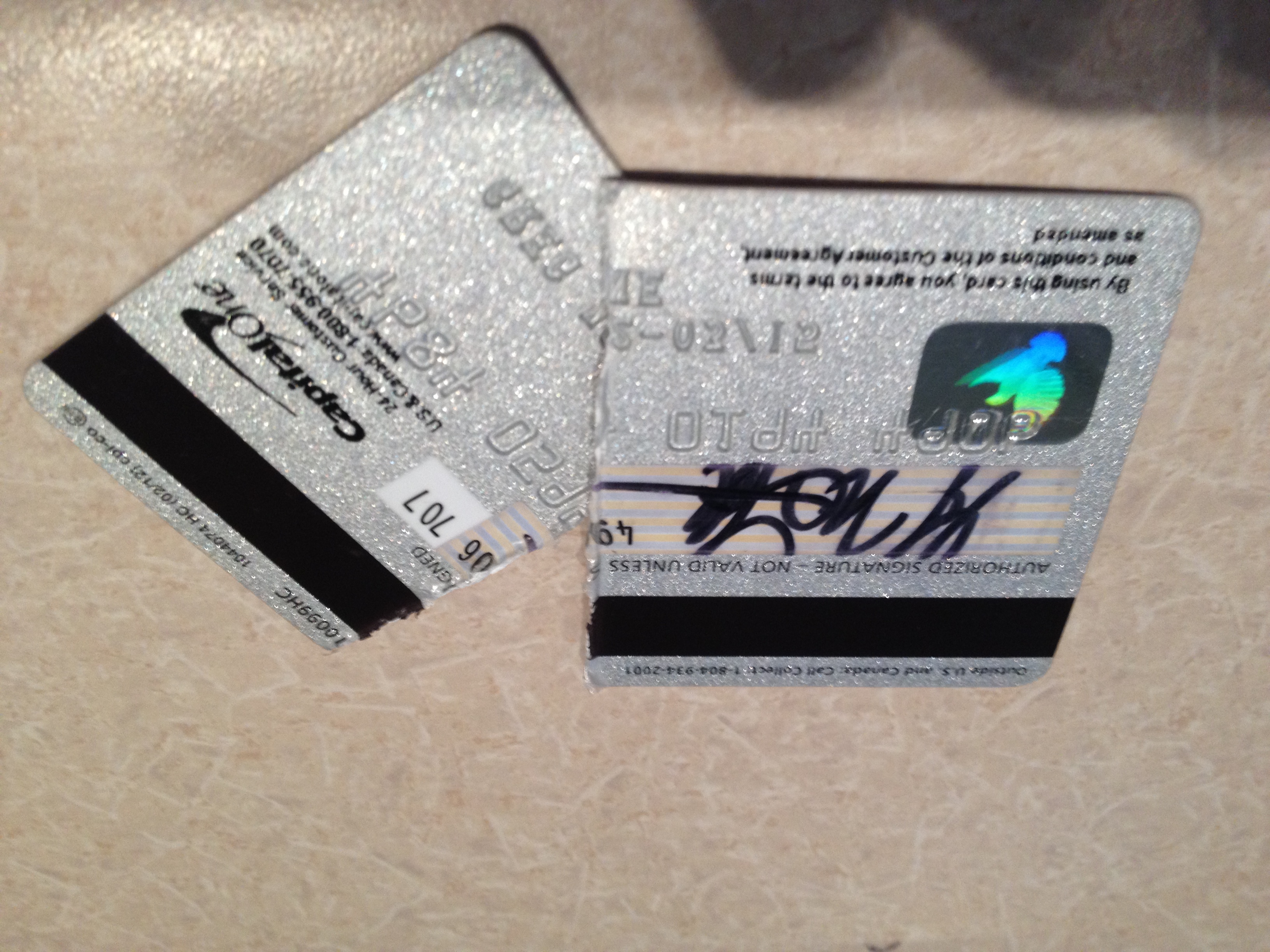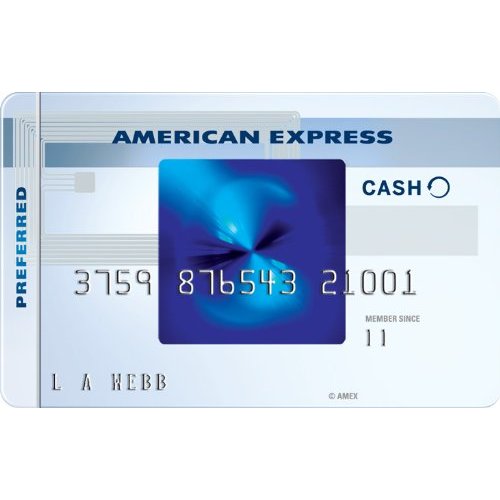
Go ahead, try and recreate the mirror images of the backs of the embossed numbers. See where it gets you.
A rare financial misstep. It didn’t cost any money, but it was inconvenient. Worse yet, now the folks at Capital One are convinced we’re crooks.
Your humble blogger had a single credit card, an American Express with a generous rewards partner. But as you probably know, not everyone takes American Express, which necessitates getting either a Visa or MasterCard. The CYC checking account card is branded with one or the other, of course, but the idea is to keep as little money in that account as possible. That way, we can put our cash to more lucrative uses.
If we ever need to buy something expensive from a retailer that doesn’t take American Express, we can either
- constantly remember the updated balance in the CYC checking account, or
- get yet another card, either Visa or MasterCard, and use it only for big purchases in places where the American Express card is no good.
So way back in the early 21st century, we graced those relentless people at Capital One with our noblesse oblige and granted them the privilege of giving us a card. God knows they weren’t ever going to get any interest payments from us, so we were acting in our capacity as free riders. Let the other Capital One cardholders carry balances, and meanwhile we’ll capitalize on the opportunity to buy stuff now and not have to pay for it for a month.
Maybe it’s our inherent frugality, or maybe it’s the places where we choose to shop, but we went months and months without ever using the Capital One card. It sat there in the wallet, neglected, watching with melancholy as the driver’s license and the National Parks pass and the concealed weapons permits got pulled out daily and went on exciting adventures.
Finally, last month, we had cause to use the Capital One card. And didn’t happen to have any identification at the time, which meant the sales clerk asked for the card’s PIN.
Uh…
1234? No, that’s crazy talk.
0000? That doesn’t work either, huh?
We discreetly paid cash, walked into the parking lot away from prying and suspicious ears, and called Capital One customer service about the little problem with our depleted long-term memory. We offered up the account password, the answers to the security questions (“Madrid”, “sea kayaking”, “July 13”), and our phone number.
Which wasn’t the phone number they had on file. That’s impossible, but they insisted the number was wrong.
After a 10-minute hold, and they probably keep you waiting that long so they can weed out the impatient common thieves who make their livelihood by stealing wallets, a manager got on the line. She asked the same questions we’d already answered, but there was still that pressing matter of not being able to remember that damned phone number, whatever it might have been.
The manager played hardball, asking a new set of questions that no card thief would know the answers to. The trouble was, only the most devoted cardholder would know the answers. For instance:
“What were your last 5 purchases?”
Dammit. The career total of purchases on this card was almost certainly less than 5, and maybe that was the answer she was looking for. Again, no clue, and again, the most recent purchase on the card was sometime during the Bush Administration. If at all.
Even though the other party was in a call center on the other side of the country somewhere, there are few things as embarrassing as being asked to give easy proof of your identity to someone who needs it and being unable to do so. If you think “I don’t know” sounds dumb when your middle school teacher asks you who the protagonist of Animal Farm is, try saying it in response to a question that indirectly requires you to assert whether you are who you say you are.
The manager went to the next test on the list, reserved only for the most obstinate and determined fraudsters. She pulled the credit report and asked, “Who’s your mortgage lender?”
CYC owns a lot of real estate. With a lot of mortgages. Even now, sitting behind a keyboard, it’d take a good 5 minutes to determine which lending institution goes with which property’s note. This is exponentially harder to do from memory.
Chase?
No.
Greenpoint?
No.
Washington Mutual?
No, that’s Chase now.
At that point, your humble blogger might as well have faked the accent of a Taiwanese Triad member who’s pretending to be an absent-minded cardholder who happens to have a Gaelic last name. It wouldn’t have worked, but it would have been less humiliating. The manager hesitated, the disdain in her voice unmistakable. We can only wonder if she wasn’t triangulating the position that the incoming call was originating from, and getting ready to sic Treasury Department agents on the offender.
Area Man Brought Down In Hail Of AR-15 Fire After Attempting To Buy Furniture With Stolen Credit Card
“Look, I don’t have that information handy. Let me get home, in front of a computer, and I’ll call you with it.”
Even now that sentence looks ridiculous, though every word of it was sincere.
Hours later, the incident had passed into the same memory landfill that got us into this predicament in the first place. Just plumb forgot about it, and got on with other things. Until several weeks later, when wouldn’t you know it, another perfect storm formed: big-ticket item, limited cash, retailer who doesn’t take American Express.
CARD DECLINED.
There was no outstanding balance of course, nor anything like that.
Went home, fired up the Capital One account page, took a deep breath, poured a stiff drink (fruit punch Gatorade) and called the 800 number. Our uncomfortable phone conversation of weeks earlier had doubtless been flagged in Capital One’s customer service database, with all sorts of red-font exclamation points and asterisks.
An agent answered, and pushed us up on the same treadmill as before. If you offered $1 million right now, we couldn’t tell you what freaking phone number they’d mistakenly attached to the account (which is clearly their fault, not ours, right?)
The agent explained that at this point, the only way to convince Capital One that we weren’t pulling a fast one would be to fax them a copy of
- Driver’s license, which will always show up clearly and legibly in a fax
- Social Security card, which disappeared 13 years ago
- A utility bill, which wouldn’t do any good anyway because all the utility bills are under the name of a Control Your Cash limited liability company instead of an individual’s name.
Oh, and items 1) and 3) are 3000 miles away right now, at the summer home. (Yes, there are separate summer and winter homes. You could be in the same situation too, if you bought our book.) This whole process could take 7 to 10 business days.
At this point, there was only one prudent thing to do. (See picture above.) Now we have to apply for another card from another issuer, and explain why we had to close our last account and/or let it lay dormant. All because we couldn’t remember some stupid string of digits.
Folks, do yourself a favor. Write EVERYTHING down. Even the stuff you think you’re never going to use. Create a document or a note on your phone. Or better yet, a contact in your list, and name it “Passwords and security questions” or something. Then, answer with glee and conviction when a suspicious Capital One customer service rep implicitly asks you to prove you didn’t steal your card. You’ll save yourself plenty of aggravation.




